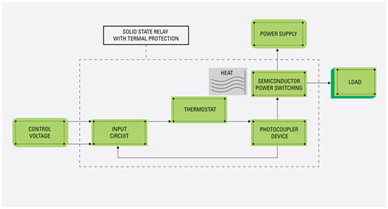How Solid-State Relays (SSRs) Faces Overheat Challenge?
Thermal Management
As Solid-State Relays (SSRs) generate heat when conducting current, there is a thermal-management component to their operation. Should overheating occur and damage an SSR, diagnosing and replacing the SSR can take time while the assembly line, machine or manufacturing system is down and out of service, running up even more costs.
To illustrate how an SSR operates, consider the product’s use in commercial-refrigeration applications in the building equipment market. In a refrigeration application, the SSR is responsible for turning the compressor on or off to keep the system’s operating temperature within a specified range. The input control circuit voltage might be 90-280 Vac with a required tripping temperature set at 95 °C. A buffer is engineered into the circuitry using a variety of components to ensure that the desired tripping action occurs as appropriate.
When the SSR turns on to conduct load current, it also generates internal heat. Failure to adequately protect the solid-state relay can cause damage to the relay or to the load.
To address this overheating challenge, SSR technology has been developed to integrate a thermostat into the SSR itself to ensure that the relay always operates in a safe or protected mode. The first SSR design of this type was developed specifically for use in a commercial refrigeration application. With some modifications, this SSR can also be used in wide variety of machines and industrial and manufacturing applications to provide similar system benefits. This design incorporates all the advantages of standard SSR technology. The temperature-sensing element is integrated directly into the SSR, so it triggers the SSR to cut off input circuit power at a specified temperature level. The SSR requires new layouts of the PC board and power section assembly.
The most important consideration is the SSR’s ambient operating temperature, which will allow for calculating the best derating for ampacity. In other words, engineers need to identify the maximum power rating, current rating or voltage rating for which the SSR is rated; then use less than those maximum ratings. This will prolong SSR life and prevent premature failures. Other points important in the selection process are the power the SSR dissipates and the heat sink used.
The automatic thermal protection is accomplished by means of the integrated thermostat embedded in the SSR (Figure 1). The thermostat senses the internal temperature of a mechanical interface with a metal plate where the internal power-switching device is mounted. If the heat exceeds the normal range, it sends a signal to the SSR to turn off the power. This built-in thermal protection completely prevents overheating conditions by providing a trip before equipment damage can occur.

Figure 1
Integrated thermostat
Figure 1: The thermostat senses the internal temperature of a mechanical interface with a metal plate where the internal power-switching device is mounted.
In addition to preventing overheating, the integrated thermal protection function can troubleshoot design issues in the system. It can help to identify incorrect heat sinking capacity in the SSR or system, poor installation resulting in insufficient heat-sinking contact, heat-dissipation efficiency of the system, as well as other issues. This provides a valuable tool to the engineer responsible for the system’s operation.
The SSR with thermal protection can also be used in a range of heating control applications such as industrial ovens, HVAC/R, sterilization equipment, molding and extrusion machinery and welding equipment. Other uses include heavy-duty conveyor systems, such as those in construction, mining, packaging and material handling. Consider a conveyor-belt application where a motor could stick and cause overload and potential damage to the system. In this case, the SSR with integrated thermal protection would prevent overheating from occurring by shutting down the conveyor belt as soon as a pre-determined heat threshold was met within the SSR’s thermostat.
In injection molding applications where limited space can cause the temperature in the cabinet to rise, thermal protection prevents the SSR from overheating if the heat sinking is not adequate, thus avoiding costly repairs. For heating systems, the thermally protected SSR can help to shut down the heating element if there is a problem with the temperature controller that causes a temperature runaway, thereby protecting the entire system.
This article is from Allicdata Electronics Limited. Reprinted need to indicate the source.


